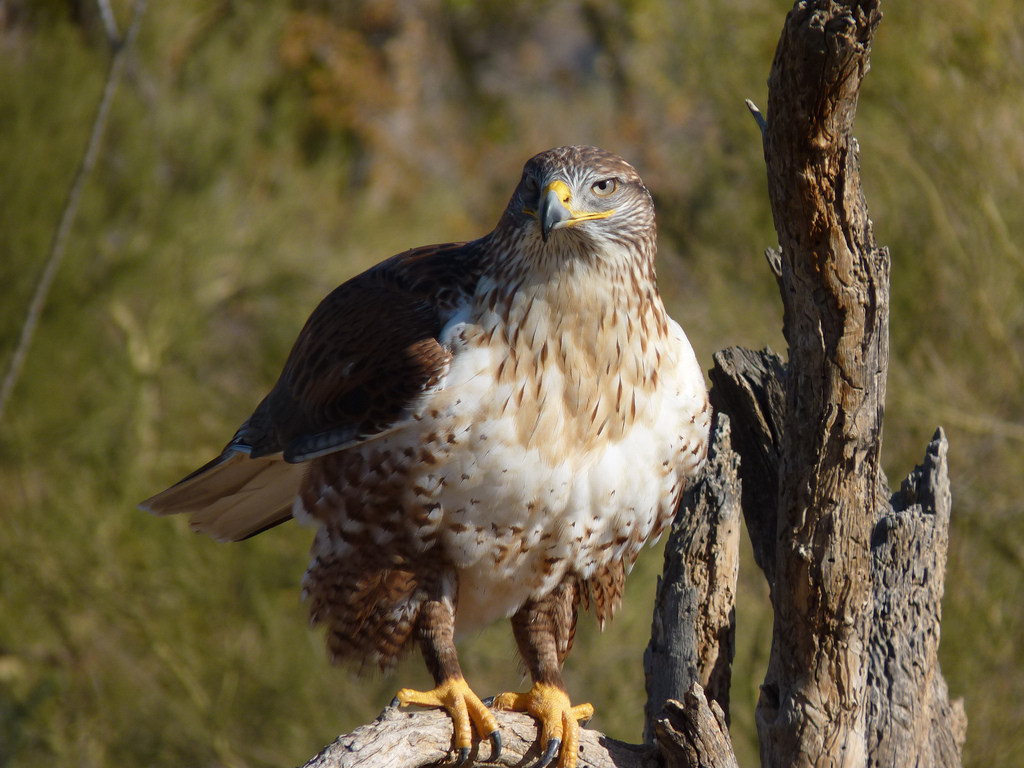
A Ferruginous Hawk perches at the Arizona-Sonora Desert Museum. Photo © B.D., licensed Creative Commons Attribution.
A big part of the fun of a visit to the Arizona-Sonora Desert Museum (2021 N. Kinney Rd., 520/883-2702, Mar.–May and Sept.–Feb. daily 7:30 a.m.–5 p.m., June–Aug. Sun.–Fri. 7:30 a.m.–5 p.m., Sat. 7:30 a.m.–10 p.m., adults $14.50, children 6–12 $5) is the getting there. Driving west out of Tucson over dramatic Gates Pass, you’ll see thousands of sentinel-like saguaros standing tall on the hot, rocky ground below, surrounded by pipe cleaner–like ocotillo and fuzzy cholla, creosote, and prickly pear. But the saguaro forests of Tucson Mountain Park and Saguaro National Park West, both of which surround the Desert Museum, are only one of several distinctive desert life zones you’ll see and learn about at this world-famous museum and zoo, where native mammals, birds, reptiles, amphibians, fish, and arthropods live in displays mimicking their open-desert habitats. This is the best place to learn about both the general structure and the minute details of the surrounding desert, and probably your only realistic chance to see all of the unique creatures that call it home.This is the best place to learn about both the general structure and the minute details of the surrounding desert, and probably your only realistic chance to see all of the unique creatures that call it home. Easy trails wind through the beautiful 21-acre preserve, passing exhibits on semidesert grasslands and mountain woodlands similar to those surrounding and growing on the Sonoran Desert’s high mountain ranges. The Desert Loop Trail leads through a lowland scrub and cactus landscape with javelina and coyote. In Cat Canyon, a bespeckled ocelot sleeps in the shade and a bobcat lounges on the rocks. A mountain lion can be seen close up through a viewing window, and a black bear strolls along a man-made stream and sleeps on a rock promontory. There are also rare Mexican wolves, white-tailed deer, bighorn sheep, and adorable prairie dogs with which to commune. A riparian habitat has beavers and otters, water lovers that were once abundant in the Southwest. There’s a desert garden exhibit, a cactus and succulent garden, and a butterfly and wildflower display. There are also displays on desert fish, dunes, and a walk-in aviary that holds dozens of native birds. Docents are scattered throughout the complex to help with questions and give presentations on special topics.All this, plus a restaurant, snack bars, and a gift shop that sells excellent Pueblo and Tohono O’odham crafts make the Desert Museum Tucson’s very best attraction. If you’re planning on doing any exploring in the desert, do so after a trip to the Desert Museum, where you’ll get a comprehensive mini-course in desert ecology.
Excerpted from the Second Edition of Moon Tucson.